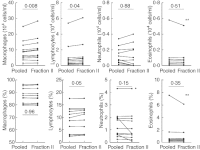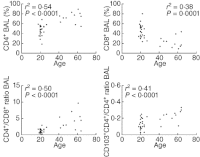Bronchoalveolar lavage cell pattern from healthy human lung
- PMID: 22288596
- PMCID: PMC3374285
- DOI: 10.1111/j.1365-2249.2011.04529.x
Bronchoalveolar lavage cell pattern from healthy human lung
Abstract
Bronchoalveolar lavage (BAL) is widely accepted as a key diagnostic procedure in interstitial lung diseases (ILD). We performed a study to obtain reference intervals of differential cell patterns in BAL fluid with special attention to the origin of lavage fluid, e.g. bronchial/alveolar, to atopy and smoking status and to age of the healthy people. We performed bronchoalveolar lavage in 55 healthy subjects with known atopy status (age: 18-64 years, non-smokers/smokers: 34/21) and determined differential cell counts and lymphocyte subsets in BAL fluid and blood. Moreover, in a subgroup of non-smoking healthy individuals we measured the expression of the regulatory T cell marker forkhead box protein 3 (FoxP3) on blood and BAL fluid lymphocytes in addition to a comprehensive set of activation markers. Differential cell counts from the alveolar lavage fraction differed significantly from calculated pooled fractions (n = 11). In contrast, marginal differences were found between atopic and non-atopic subjects. Interestingly, the BAL fluid CD4(+) /CD8(+) ratio correlated strongly with age (r(2) = 0·50, P < 0·0001). We consider the bronchial and alveolar fraction to be lavage fluid from fundamentally different compartments and recommend analysis of the alveolar fraction in diagnostic work-up of ILD. In addition, our data suggest that age corrected BAL fluid CD4(+) /CD8(+) ratios should be used in the clinical evaluation of patients with interstitial lung diseases.
© 2011 The Authors. Clinical and Experimental Immunology © 2011 British Society for Immunology.
Figures




Similar articles
-
Evaluating the Diagnostic Value of Lymphocyte Subsets in Bronchoalveolar Lavage Fluid and Peripheral Blood Across Various Diffuse Interstitial Lung Disease Subtypes.Biomolecules. 2025 Jan 14;15(1):122. doi: 10.3390/biom15010122. Biomolecules. 2025. PMID: 39858516 Free PMC article.
-
[Use of flow cytometry in evaluation of cellular changes in interstitial lung diseases].Folia Med Cracov. 1997;38(3-4):69-115. Folia Med Cracov. 1997. PMID: 10481384 Clinical Trial. Polish.
-
[Comparative analysis of bronchoalveolar lavages in interstitial lung diseases].Korean J Lab Med. 2007 Jun;27(3):221-7. doi: 10.3343/kjlm.2007.27.3.221. Korean J Lab Med. 2007. PMID: 18094580 Korean.
-
[Phenotype of alveolar lymphocytes--theoretical and practical implications].Przegl Lek. 2000;57(9):493-8. Przegl Lek. 2000. PMID: 11199873 Review. Polish.
-
Bronchoalveolar lavage: role in the evaluation of pulmonary interstitial disease.Expert Rev Respir Med. 2020 Nov;14(11):1117-1130. doi: 10.1080/17476348.2020.1806063. Epub 2020 Aug 26. Expert Rev Respir Med. 2020. PMID: 32847429 Review.
Cited by
-
Comprehensive transcriptomic analysis of COVID-19 blood, lung, and airway.Sci Rep. 2021 Mar 29;11(1):7052. doi: 10.1038/s41598-021-86002-x. Sci Rep. 2021. PMID: 33782412 Free PMC article.
-
Targeted Gene Expression Profiling of Human Myeloid Cells From Blood and Lung Compartments of Patients With Tuberculosis and Other Lung Diseases.Front Immunol. 2022 Mar 8;13:839747. doi: 10.3389/fimmu.2022.839747. eCollection 2022. Front Immunol. 2022. PMID: 35356003 Free PMC article.
-
Protocol for isolating extracellular vesicles from human or mouse airway macrophages for functional assays and in vivo or in vitro experimentation.STAR Protoc. 2025 Jun 20;6(2):103867. doi: 10.1016/j.xpro.2025.103867. Epub 2025 Jun 2. STAR Protoc. 2025. PMID: 40460201 Free PMC article.
-
Compartmental immunophenotyping in COVID-19 ARDS: A case series.J Allergy Clin Immunol. 2021 Jan;147(1):81-91. doi: 10.1016/j.jaci.2020.09.009. Epub 2020 Oct 23. J Allergy Clin Immunol. 2021. PMID: 32979342 Free PMC article. Clinical Trial.
-
Pulmonary Immune Dysregulation and Viral Persistence During HIV Infection.Front Immunol. 2022 Jan 4;12:808722. doi: 10.3389/fimmu.2021.808722. eCollection 2021. Front Immunol. 2022. PMID: 35058937 Free PMC article. Review.
References
-
- Costabel U, Guzman J. Bronchoalveolar lavage in interstitial lung disease. Curr Opin Pulm Med. 2001;7:255–61. - PubMed
-
- Heron M, Slieker WA, Zanen P, et al. Evaluation of CD103 as a cellular marker for the diagnosis of pulmonary sarcoidosis. Clin Immunol. 2008;126:338–44. - PubMed
-
- Meyer KC. The role of bronchoalveolar lavage in interstitial lung disease. Clin Chest Med. 2004;25:637–49. - PubMed
-
- Cordeiro CR, Jones JC, Alfaro T, Ferreira AJ. Bronchoalveolar lavage in occupational lung diseases. Semin Respir Crit Care Med. 2007;28:504–13. - PubMed
-
- Meyer KC. Bronchoalveolar lavage as a diagnostic tool. Semin Respir Crit Care Med. 2007;28:546–60. - PubMed
MeSH terms
Substances
LinkOut - more resources
Full Text Sources
Research Materials

